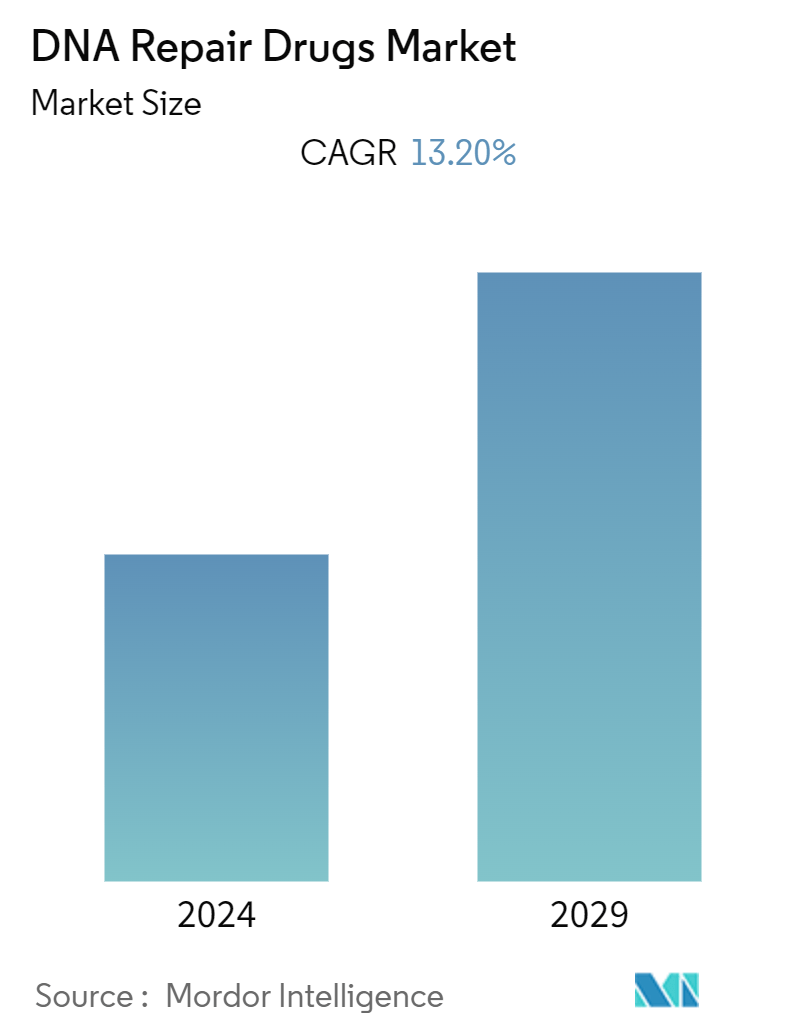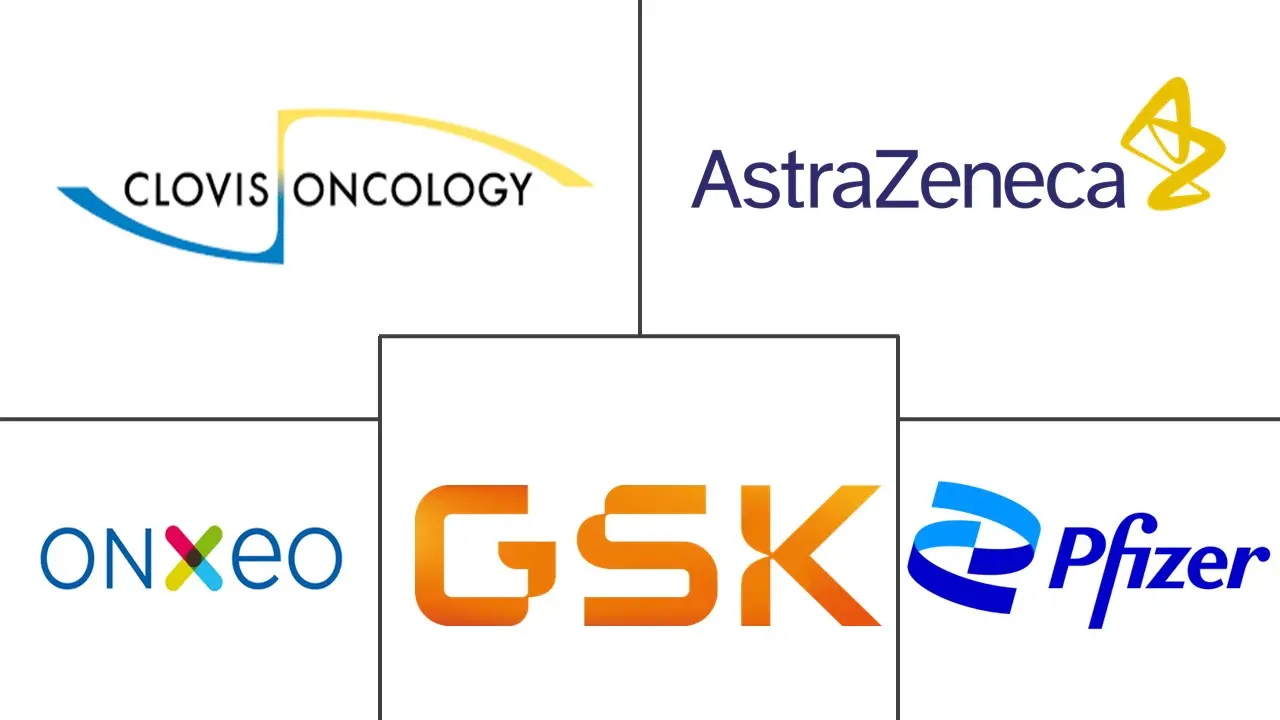Market Size of DNA Repair Drugs Industry

| Study Period | 2019 - 2029 |
| Base Year For Estimation | 2023 |
| CAGR (2024 - 2029) | 13.20 % |
| Fastest Growing Market | North America |
| Largest Market | Asia-Pacific |
| Market Concentration | Low |
Major Players
*Disclaimer: Major Players sorted in no particular order |
DNA Repair Drugs Market Analysis
The DNA Repair Drugs Market is expected to register a CAGR of 13.20% during the forecast period.
The DNA repair drugs market is expected to grow significantly over the forecast period owing to factors such as the growing burden of cancer worldwide and increasing research and development for novel drugs and treatments. The incidence and prevalence of various types of cancer are increasing due to lifestyle changes along with the factors that increase the risk of developing cancer, such as increasing consumption of alcohol and smoking, obesity, as well as a family history of cancer. This is expected to boost the demand and the need to develop effective and safe DNA repair cancer drugs, propelling the market’s growth.
For instance, according to data published by the International Agency for Research on Cancer in February 2024, the overall prevalence of cancer cases globally was reported to be 14.1 million in 2022, with the highest in Asia, amounting to 6.4 million, followed by 3.5 million in Europe. Thus, the increased number of cancer cases among the population further fuels the demand for DNA repair drugs, propelling the market’s growth.
Furthermore, companies' rising focus on researching and developing novel drugs for treating cancer also contributes to market growth. For instance, in February 2024, the National Cancer Institute (NCI) funded new research to target lethal prostate cancer by exploring the role of BRCA2 “DNA damage repair genes” to create new therapeutics. Thus, new funding for developing new DNA repair drugs is expected to boost the market significantly over the forecast period.
Therefore, the market studied is expected to grow over the forecast period due to factors such as the high prevalence of cancer and the rising focus on research and development activities. However, the strict regulation of product approvals will likely impede the growth of the DNA repair drugs market over the forecast period.
DNA Repair Drugs Industry Segmentation
As per the scope of the report, DNA repair drugs are the drugs that are majorly used in treating cancers. DNA repair drugs are known to inhibit DNA repair enzymes and kill cancer cells with defects in DNA repair due to mutations in DNA repair genes.
The DNA repair drugs market is segmented by drug type, application, distribution channel, and geography. By drug type, the market is segmented into olaparib, rucaparib, niraparib, talazoparib, and other drug types. By application, the market is segmented into ovarian cancer, fallopian tube cancer, peritoneal cancer, breast cancer, and other application types. The other applications segment includes prostate cancer, pancreatic cancer, etc. By distribution channel, the market is segmented into hospital pharmacies, retail pharmacies, and other distribution channels. By geography, the market is segmented into North America, Europe, Asia-Pacific, and the Rest of the World. The market report also covers the estimated market sizes and trends for 13 different countries across major regions globally. The report offers the value (USD) for the above segments.
| By Drug Type | |
| Olaparib | |
| Rucaparib | |
| Niraparib | |
| Talazoparib | |
| Other Drug Types |
| By Application | |
| Ovarian Cancer | |
| Fallopian Tube Cancer | |
| Peritoneal Cancer | |
| Breast Cancer | |
| Other Applications |
| By Distribution Channel | |
| Hospital Pharmacies | |
| Retail Pharmacies | |
| Other Distribution Channels |
| Geography | ||||||||
| ||||||||
| ||||||||
| ||||||||
| Rest of the World |
DNA Repair Drugs Market Size Summary
The DNA repair drugs market is poised for significant growth, driven by the increasing global burden of cancer and advancements in research and development for novel treatments. The market experienced a temporary setback due to the COVID-19 pandemic, which disrupted cancer diagnosis and treatment services, thereby affecting the demand for DNA repair drugs. However, as restrictions have eased and services have resumed, the market is expected to recover and expand. Factors such as lifestyle changes leading to a rise in cancer incidence, the growing focus on developing effective cancer therapies, and the integration of innovative technologies like artificial intelligence in drug development are contributing to the market's positive outlook. Despite the promising growth trajectory, stringent regulatory requirements for product approvals may pose challenges to market expansion.
North America is anticipated to be a key region for market growth, supported by increased research and development activities, substantial investments, and a high prevalence of cancer. The demand for DNA repair drugs is expected to rise, fueled by the growing number of cancer cases and the ongoing efforts by companies to develop and approve new treatments. The market is characterized by the presence of several global players, including AstraZeneca, Clovis Oncology, GlaxoSmithKline, Pfizer, and Onxeo, who are actively engaging in strategies such as partnerships, collaborations, and product launches to enhance their market presence. The approval of new drugs and the increasing adoption of existing ones, such as Olaparib, are further expected to drive market growth over the forecast period.
DNA Repair Drugs Market Size - Table of Contents
-
1. MARKET DYNAMICS
-
1.1 Market Overview
-
1.2 Market Drivers
-
1.2.1 Growing Burden of Cancer Worldwide
-
1.2.2 Increasing Research and Development for Novel Drugs and Treatment
-
-
1.3 Market Restraints
-
1.3.1 Strict Regulations for Product Approval
-
-
1.4 Porter's Five Forces Analysis
-
1.4.1 Threat of New Entrants
-
1.4.2 Bargaining Power of Buyers/Consumers
-
1.4.3 Bargaining Power of Suppliers
-
1.4.4 Threat of Substitute Products
-
1.4.5 Intensity of Competitive Rivalry
-
-
-
2. MARKET SEGMENTATION (Market Size by Value - USD)
-
2.1 By Drug Type
-
2.1.1 Olaparib
-
2.1.2 Rucaparib
-
2.1.3 Niraparib
-
2.1.4 Talazoparib
-
2.1.5 Other Drug Types
-
-
2.2 By Application
-
2.2.1 Ovarian Cancer
-
2.2.2 Fallopian Tube Cancer
-
2.2.3 Peritoneal Cancer
-
2.2.4 Breast Cancer
-
2.2.5 Other Applications
-
-
2.3 By Distribution Channel
-
2.3.1 Hospital Pharmacies
-
2.3.2 Retail Pharmacies
-
2.3.3 Other Distribution Channels
-
-
2.4 Geography
-
2.4.1 North America
-
2.4.1.1 United States
-
2.4.1.2 Canada
-
2.4.1.3 Mexico
-
-
2.4.2 Europe
-
2.4.2.1 Germany
-
2.4.2.2 United Kingdom
-
2.4.2.3 France
-
2.4.2.4 Italy
-
2.4.2.5 Spain
-
2.4.2.6 Rest of Europe
-
-
2.4.3 Asia-Pacific
-
2.4.3.1 China
-
2.4.3.2 Japan
-
2.4.3.3 India
-
2.4.3.4 Australia
-
2.4.3.5 South Korea
-
2.4.3.6 Rest of Asia-Pacific
-
-
2.4.4 Rest of the World
-
-
DNA Repair Drugs Market Size FAQs
What is the current DNA Repair Drugs Market size?
The DNA Repair Drugs Market is projected to register a CAGR of 13.20% during the forecast period (2024-2029)
Who are the key players in DNA Repair Drugs Market?
AstraZeneca plc, Clovis Oncology, Pfizer Inc., Onxeo and GSK plc are the major companies operating in the DNA Repair Drugs Market.

